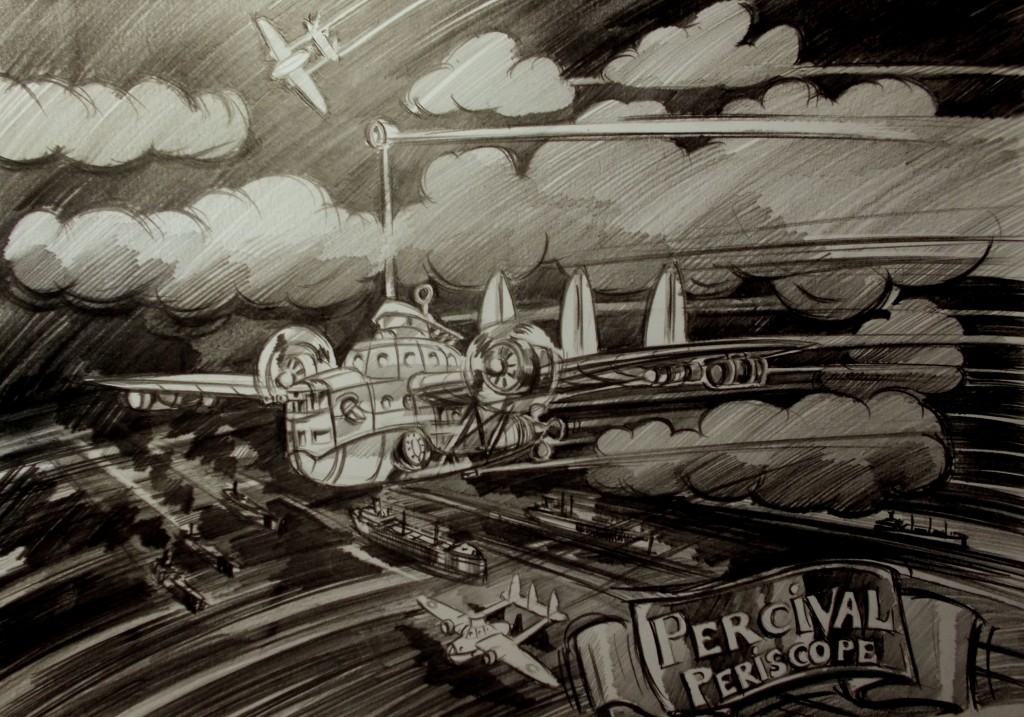Dear reader. Once again Cockburn and Poole draw another half light upon the uncelebrated triumphs of Australian manufacturing and derring do.
In response to Air Ministry Specification (22/35) 11April 1935, for a twin engine, long range reconnisance and anti submarine patrol flying boat, the Percival aircraft maufacturing Company’s Melbourne office was selected in a restricted competition with Short bros, Supermarine and Avro.

Percival Periscope Mk11 on anti submarine convoy duties Northern Approaches July 1943. This particular example 3 Squadron RAAF based Crouch estuary. Burnham.
Without experience gained by the principal players Short and Supermarine, the Proctor integrated the boom and tail unit from the Short Singapore, and adapted the Rolls Royce Kestrel engines then in use on the Stranraer. Preliminary testing indicated a tendency to roll at high altitude and poor seagoing capabilities when planing and taxiing. To counter this, Perceval reduced weight and upgraded the engines, replacing the Kestrel with the then newly developed Bristol Hercules. Using this heavy lift capability the Periscope outperformed its rivals at medium height, (below 10000 feet) but still had a tendency to roll, pitch and yaw on water. It’s range was extended with auxiliary tanks, and to improve crew comfort, the fuselage was fully pressurized. In spite of continued hydrodynamic development the prototype still planed inadequately with an increased tendency to “bow” and plunge in anything but the calmest waters.. Exasperated the Chief Technical Engineer, Lt Cmdr. Ivor Crutchrot RAN, decided to fully enclose the cockpit and with supercharged engines engage full throttle for takeoff. The opposite happened, the Perceval became fully submerged, and with water ethanol and poor carburetion surprisingly performed just as well below water as above it. Seizing on this discovery the hull was reinforced, and made completely amphibious. The final prototype combined both the qualities of long range maritime patrol and underwater, short hop submarine interception. The addition of the propeller, geared to the crankshaft of the Hercules, gave an underwater speed of at least seven knots, and an air speed of 180 mph. Seizing on the adaptations as the first ever truly stealth surveillance aircraft, the Periscope was adapted for cruising below cloud ceiling, enabling it to “duck and cover” upon the approach of enemy aircraft. Semi submerged it mimicked the appearance of a type V11 C U Boat and on numerous occasions escaped undetected.
Shown here, a Periscope Mk 1V of Coastal Command RAAF is patrolling a convoy off the Northern Approaches. Note the underslung 100 lb bombs, and the forward facing twin mounted Boulton Paul, (ex Defiant turret). The type were withdrawn from service due to the unreliability of the electrical system, (Lucas) and the tendency when forced to submerge for the depth charges, (twin 250 lb) to explode, atomizing aircraft and crew.
This particular aircraft was involved in the celebrated hunt for the raider SMS Shrek, and delivered the coup de grace when under fire from HMS Passive and HMAS Agressive during the closing stages of the battle of the River Phoenix. It was in this engagement the crew threw overboard their defunctive, Secret High Energy Intercept Locator Apparatus, (SHEILA) which killed the captain of the Shrek, Kpt Lt, Henda Hoch, and resulted in the crews surrender. The first and only time a SHEILA was used to such effect. Only one example survives at the Commonwealth Research Facility in Canberra, where it is being used as a test bed to upgrade the current generation of Collins Class submarines.
Specifications: Crew: 5.
Range: 1500 miles (on air) 15 miles (underwater).
Powerplant: Two Bristol Hercules.
Armament 2 x .303 Vickers machine Guns in bow turret.
2 x 100 lb bombs.
2 x 250 lb depth charges.
